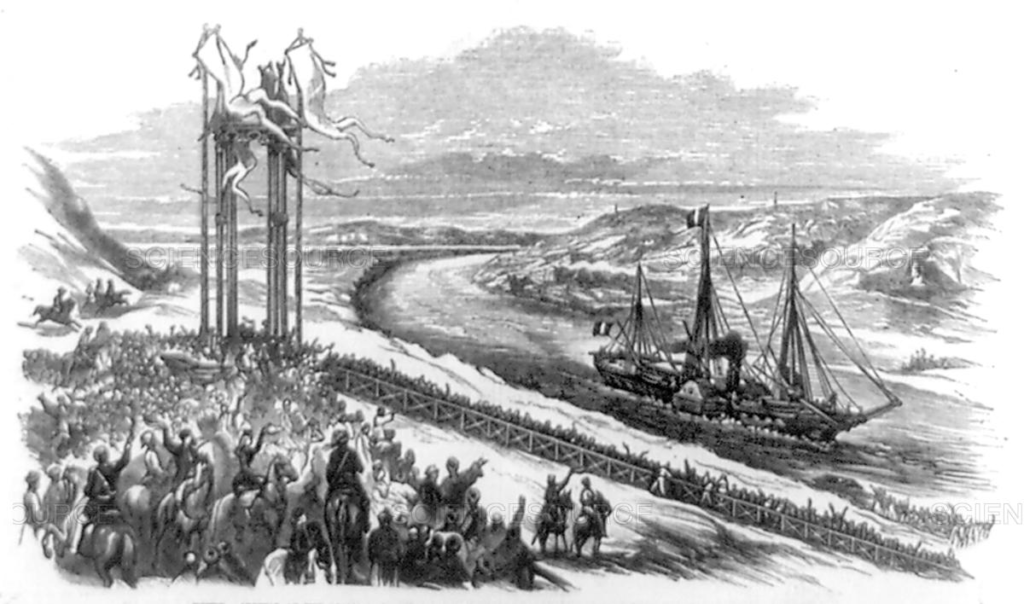
As tugs battled to free and refloat the stranded Ever Given, the huge container ship that has been wedged in the Suez Canal for almost a week, Mike Guilfoyle’s thoughts turned to his cemetery notes and a local link to the opening of the canal in 1869. The vice-chair of the Friends of Brockley and Ladywell Cemeteries recalls the vital role played by naval engineer William Henry Jackson.

The excavation for the Suez Canal took about 10 years using forced labour of Egyptian workers. Some estimate that more than 30,000 people were working on the canal at any given period, that more than 1.5 million people from various countries were employed, and that thousands of laborers died.
The canal opened under French control on 17 November 1869. Due to its strategic importance as a waterway between Africa and Asia it then effectively came under British control from 1888 until the Suez Crisis of 1956.
But it was the plight of the Ever Given and the incongruous image of a this huge container ship blocking the Suez Canal, one of the world’s busiest trade routes, that prompted a quick search of my cemetery notes. They revealed a fascinating local link to the opening of the Suez Canal in 1869.
A London born naval engineer called William Henry Jackson was employed for a time with the Greenwich Marine firm of John Penn and Sons.
He was then appointed by John Penn to be engineer in the steam yacht “Mahrousseh,” built by the Isle of Dogs Shipbuilders, Messrs. Samuda Brothers for the Viceroy of Egypt.
They finished constructing Al Mahrousa in April 1865. The ship, running on coal, then sailed up the River Thames from London to Alexandria.

In 1869, Al Mahrousa was the first ever sail ship to cross the Suez Canal, holding Khedive Ismail and French Empress Eugenie, the wife of Napoleon III.
Accompanying them were other royals including the Dutch prince and princess, as well as Austrian Franz Joseph, among others.
A piano played by Eugenie at the opening is reportedly still on the ship in its original state.
Khedive Ismail, wanted to celebrate the opening of the Suez Canal by building one of the world’s largest and most luxurious yachts, which would serve as a main means of transportation for the royal family.

In 1975, President Anwar Al Sadat used the ship to travel to Jaffa to sign the peace agreement with Israel.
William Henry Jackson later became chief engineer for the Viceroy, and was created a Bey. (In the Ottoman Empire an honorific title conferred on certain officials or nobles.)
On leaving the service of the Khedive, he became superintending engineer to the General Steam Navigation Co, retaining this position until his death, which took place at Stowage House, Deptford on 2nd November 1884, at the age of 60.
He was interred in Brockley cemetery on the 6 th November, 1884.
William Henry Jackson’s obituary can be read on Grace’s Guide to British Industrial History :https://www.gracesguide.co.uk/Henry_James_Jackson
The General Steam Navigation Company was the first shipping company in the world to begin business directly with steamships.
Footnote: Visitors to the cemetery from the Brockley entrance will most likely have passed the imposing Norfolk family headstone which on one side is inscribed Major Harold Norfolk, Worcester Yeomanry,Younger son of Edward and Alice Norfolk, killed in War at Oghratina, Egypt, April 23 rd 1916. (This was during the campaign to defend the British Empire protected Suez Canal against German-led Ottoman forces who launched their attack from the Sinai peninsula.)
